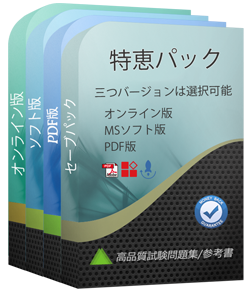NCA-GENM試験認定を取られるメリット
ほとんどの企業では従業員が専門試験の認定資格を取得する必要があるため、NCA-GENM試験の認定資格がどれほど重要であるかわかります。テストに合格すれば、昇進のチャンスとより高い給料を得ることができます。あなたのプロフェッショナルな能力が権威によって認められると、それはあなたが急速に発展している情報技術に優れていることを意味し、上司や大学から注目を受けます。より明るい未来とより良い生活のために私たちの信頼性の高いNCA-GENM最新試験問題集を選択しましょう。
NVIDIA Generative AI Multimodal試験学習資料での高い復習効率
ほとんどの候補者にとって、特にオフィスワーカー、NCA-GENM試験の準備は、多くの時間とエネルギーを必要とする難しい作業です。だから、適切なNCA-GENM試験資料を選択することは、NCA-GENM試験にうまく合格するのに重要です。高い正確率があるNCA-GENM有効学習資料によって、候補者はNVIDIA Generative AI Multimodal試験のキーポイントを捉え、試験の内容を熟知します。あなたは約2日の時間をかけて我々のNCA-GENM試験学習資料を練習し、NCA-GENM試験に簡単でパスします。
NCA-GENM試験学習資料を開発する専業チーム
私たちはNCA-GENM試験認定分野でよく知られる会社として、プロのチームにNVIDIA Generative AI Multimodal試験復習問題の研究と開発に専念する多くの専門家があります。したがって、我々のNVIDIA-Certified Associate試験学習資料がNCA-GENM試験の一流復習資料であることを保証することができます。私たちは、NVIDIA-Certified Associate NCA-GENM試験サンプル問題の研究に約10年間集中して、候補者がNCA-GENM試験に合格するという目標を決して変更しません。私たちのNCA-GENM試験学習資料の質は、NVIDIA専門家の努力によって保証されています。それで、あなたは弊社を信じて、我々のNVIDIA Generative AI Multimodal最新テスト問題集を選んでいます。
無料デモをごダウンロードいただけます
様々な復習資料が市場に出ていることから、多くの候補者は、どの資料が適切かを知りません。この状況を考慮に入れて、私たちはNVIDIA NCA-GENMの無料ダウンロードデモを候補者に提供します。弊社のウェブサイトにアクセスしてNVIDIA Generative AI Multimodalデモをダウンロードするだけで、NCA-GENM試験復習問題を購入するかどうかを判断するのに役立ちます。多数の新旧の顧客の訪問が当社の能力を証明しています。私たちのNCA-GENM試験の学習教材は、私たちの市場におけるファーストクラスのものであり、あなたにとっても良い選択だと確信しています。
Tech4Examはどんな学習資料を提供していますか?
現代技術は人々の生活と働きの仕方を革新します(NCA-GENM試験学習資料)。 広く普及しているオンラインシステムとプラットフォームは最近の現象となり、IT業界は最も見通しがある業界(NCA-GENM試験認定)となっています。 企業や機関では、候補者に優れた教育の背景が必要であるという事実にもかかわらず、プロフェッショナル認定のようなその他の要件があります。それを考慮すると、適切なNVIDIA NVIDIA Generative AI Multimodal試験認定は候補者が高給と昇進を得られるのを助けます。
NVIDIA Generative AI Multimodal 認定 NCA-GENM 試験問題:
1. Consider the following scenario: You're training a GAN for generating high-resolution images (e.g., 1024x1024). You notice that the training process is unstable, with the generator and discriminator constantly oscillating. Which of the following architectural modifications and training techniques could help stabilize the training process?
A) Applying batch normalization in both the generator and discriminator.
B) Increasing the learning rate of both the generator and discriminator.
C) Using Wasserstein GAN (WGAN) with gradient penalty (GP).
D) Using ReLU activation functions in the discriminator.
E) Replacing standard convolutional layers with transposed convolutional layers in the generator.
2. You're building a multimodal model that integrates text, images, and audio. The text data has many missing values. Which of the following strategies would be MOST effective for handling missing text data while leveraging the other modalities?
A) Use a simple imputation method like replacing missing text with a placeholder like 'unknown'.
B) Use a multimodal generative model (e.g., VAE, GAN) to impute the missing text based on the learned joint representation of all modalities.
C) Train a separate model to predict the missing text based on the available image and audio data, then impute the predicted values.
D) Remove all data points with missing text values to ensure data integrity.
E) Ignore the missing text values during training, assuming the model can learn from the available modalities.
3. Which of the following techniques can be used to improve the factual accuracy of text generated by a large language model?
A) Using retrieval-augmented generation (RAG) to ground the model's knowledge in external sources.
B) Always using the same prompt, regardless of the desired output.
C) Applying a temperature of 0 during text generation.
D) Fine-tuning the model on a dataset of factually correct information.
E) Increasing the model size and training it on more data.
4. You are training a multimodal model that combines text and images. You observe that the model is heavily biased towards the text modality and largely ignores the image data. Which of the following strategies could you use to address this modality imbalance? (Select all that apply)
A) Decrease the learning rate for the text-related parameters of the model.
B) Oversample the image data during training.
C) Increase the learning rate for the image-related parameters of the model.
D) Use a modality-specific loss weighting scheme, assigning a higher weight to the loss component derived from the image data.
E) Reduce the dimensionality of the image features to match the dimensionality of the text embeddings.
5. Consider a multimodal dataset containing patient records: text descriptions of symptoms, MRI images, and audio recordings of heart sounds. Some records are missing MRI images. Which of the following methods is BEST suited for handling this missing data within a multimodal learning framework?
A) Imputing missing MRI images using the average MRI image from the entire dataset.
B) Training a separate model only on records with complete data and then using it to predict the missing data.
C) Deleting all records with missing MRI images.
D) Ignoring the MRI data completely and training the model only on the text and audio data.
E) Using a masking approach during training, where the model is trained to predict the missing modality (MRI) from the available modalities (text and audio) for incomplete records and is trained with all modalities for complete records.
質問と回答:
| 質問 # 1 正解: A、C | 質問 # 2 正解: B | 質問 # 3 正解: A、D、E | 質問 # 4 正解: A、B、C、D | 質問 # 5 正解: E |


 弊社は製品に自信を持っており、面倒な製品を提供していません。
弊社は製品に自信を持っており、面倒な製品を提供していません。


 Sakaguchi
Sakaguchi


